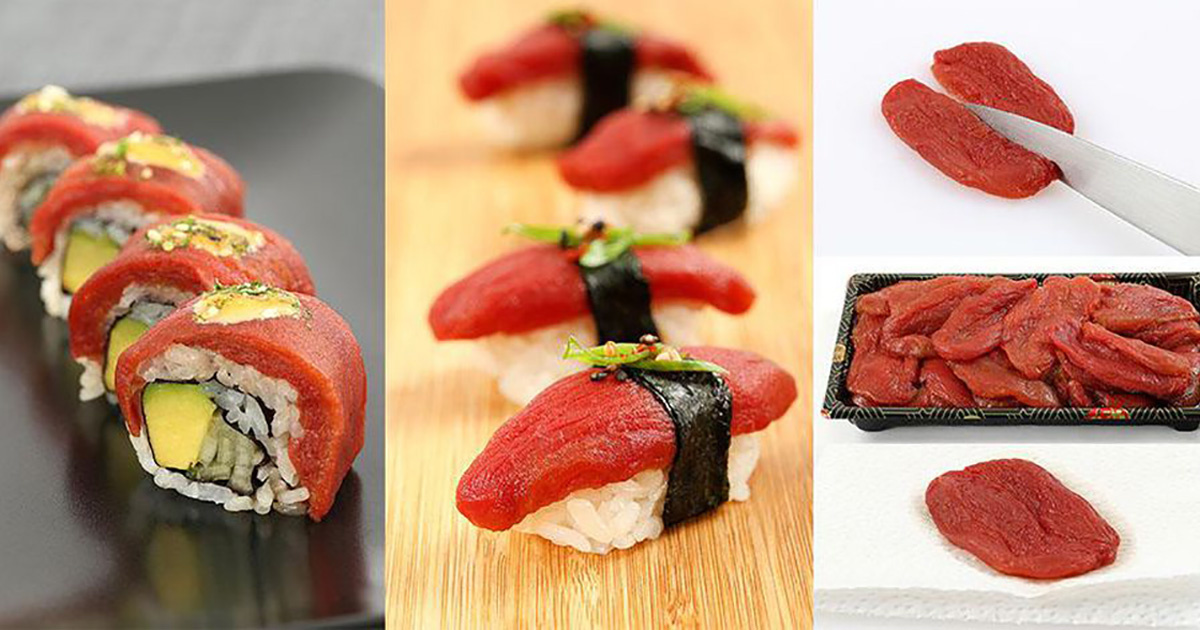
5 Reasons Why Vegan Seafood Is About to Get Super Popular

Ocean Hugger Foods' Ahimi is the first plant-based alternative to raw tuna, used in restaurants and the food service sector. Ocean Hugger Foods
By Uzo
You may already know how delicious vegan seafood is. Word on the street is that fishless fare is making a huge appearance in stores nationwide.
According to Forbes, vegan seafood will soon become “big business.” Yummy fish-free products from companies like Sophie’s Kitchen, Gardein and Ocean Hugger Foods—whose Ahimi (aka “tomato sushi”) can be found at Whole Foods and Sprouts stores and in university cafeterias across the U.S.—are making waves. With so many tasty plant-based seafood options available, it’s becoming even easier to see that humans shouldn’t eat sea animals.
[instagram https://www.instagram.com/p/BfUPIEHDcWD/?utm_source=ig_web_copy_link expand=1]
Check out five reasons why everyone needs to jump on the vegan seafood bandwagon:
1. You Won’t Be Contributing to Overfishing and Slave Labor
[instagram https://www.instagram.com/p/BnhudEWh4iP/?utm_source=ig_embed expand=1]
According to a 2016 report in
Nature Communications, many more fish around the world were caught between 1950 and 2010 than was previously reported, which has led to a steep decline in the number of fish in the sea. Plus, since industrial fisheries use large nets to sweep the ocean bed, millions of other sea animals like whales, turtles and dolphins get caught and killed in the nets. (This is the “bycatch” that you may have heard of.)
In addition to causing sea animals to suffer, fishing harms humans, too. The
shrimp industry is notorious for using slave labor. According to New Wave Foods CEO Dominique Barnes, shrimp companies in Southeast Asia entice people to work for them who then “become slaves to the industry.” There have been reports that the unpaid workers are confined and even tortured.
2. Fishing Results in Extreme Pain
Simply put, fish are slaughtered in the worst ways. Fish-slaughter plants in the U.S. often don’t stun the animals, so they’re fully conscious and in pain when their gills are cut and they’re bled to death. Large fish like salmon are sometimes bashed on the head with a wooden bat, and many are fatally injured but still alive when they’re cut open.
Studies have shown that lobsters, crabs and other crustaceans
can feel pain. Crabs and other crustaceans will pick at their limbs for extended periods of time when they’re injured, just as humans and other animals do. This isn’t simply a reflex: Crustaceans rub at injuries because they have central nervous systems and feel pain.
3. Marine Animals Are Like You, Only Different
Humans and crustaceans are more alike than you might think. Crabs, lobsters and other sea animals are intelligent, sentient beings. Crabs and lobsters make decisions based on past painful events. Lobsters carry their young for nine months—and in the wild, they travel great distances and can live for up to 100 years.
4. You’ll Save Nearly 200 Animals Every Year
Being vegan definitely has its perks. One of them is being a true hero to animals: By going vegan, you can save nearly 200 of them each year!
[instagram https://www.instagram.com/oceanhuggerfoods/?utm_source=ig_embed expand=1]
5. Vegan Seafood Is Super-Delish
You saw the scrumptious-looking fishless sushi roll above, so you know what’s up. In addition to Ocean Hugger Foods’ products, there are
many vegan seafood options that you can try to your heart’s content. So the next time you’re craving a tuna salad sandwich, why not pair a can of Toona from Sophie’s Kitchen with some vegan mayo? Your taste buds will thank you.
[instagram https://www.instagram.com/p/BSjLTtGASNB/?utm_source=ig_embed expand=1]
Feeling Inspired?
Try vegan! With so many meat-free options on the market, it’s easier than ever to keep cruelty off your plate. Check out our
Guide to Going Vegan for tasty recipes, meals and more! From breakfast to midnight snacks, we’ve got you covered.
- Vegan Coffee Creamers for the Perfect Morning Cup
- 'A Vegan Diet Is Probably the Single Biggest Way to Reduce Your ...

 233k
233k  41k
41k  Subscribe
Subscribe 